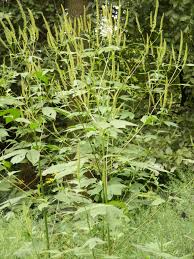 |
| Common ragweed hiding in the goldenrod. |
My eyelids are swollen, and tears are
flowing. And, if my nose runs anymore,
there will no longer be any liquid left in my body. People avoid me because they think I have
some dreaded disease. I sniff and sneeze
in my private torment, taking little comfort in the knowledge that 25 million
others commiserate with me. All this
misery is because of a condition known as Allergic
rhinitis.
The
culprit that causes this condition is ragweed, whose billions of grains of
pollen are released on these wonderful fall days. Ragweed is indigenous to most of the United
States; however, the greatest ragweed concentrations occur in the Midwest. Around Cincinnati, a square mile of ragweed
might shed 16 tons of pollen a year.
Nationally, an estimated 250,000 tons or more of ragweed pollen are
released into the atmosphere year and each grain can travel more than 100 miles
from its source. No wonder allergies
symptoms run wild in the fall each year!
The persons who count and weigh these near-microscopic pollen grains
must lead a monastic lifestyle.
Ragweed
is a pest that invades horticultural and agronomic crops, pastures, and highway
rights-of-ways. There are 2 species of
ragweed - giant ragweed (Ambrosia trifida)
and common ragweed (Ambrosia
artemisiifolia) that cause most of the misery. Before common ragweed becomes a tear-making
culprit, it exists as a plant with a distinctly unique appearance. The grayish-green leaves are deeply lobbed,
giving them a lace-like appearance.
Careful pruning will keep this plant compact. These characteristics make ragweed a
candidate for pot culture. Just remove
the flowers before they release their pollen.
Giant
ragweed, on the other hand, can grow to 15 feet tall. My first experience with giant ragweed was as
a child when I removed insect larvae from stem galls to use as fishing bait.
So,
how do we cope with ragweed (and other) pollen?
To reduce exposure to ragweed pollen, it is best to avoid the outdoors
between 6-10 AM and also dry, hot, windy days.
The best time to be outside is in the late afternoon or after a heavy
rain because pollen levels are lower during these times. When gardening or mowing the lawn, wear a
particle mask. Take your allergy
medications before going outdoors. Wear
sunglasses to keep pollen from getting into your eyes. After being outdoors, it is best to shower
and change clothing. Pollen can adhere
to clothing, skin, and hair. Be aware
that your pet can also transport pollen into your home.
Ah
choo! In case you haven't figured out
what Allergic rhinitis is, it is hay
fever ... no hay and rarely any fever.
Remember hay fever is mostly caused by ragweed pollen, not goldenrod
flowers. However, goldenrods are
usually blamed because their glorious yellow flowers distract one from seeing
the incipient green flowers of ragweed.
 |
| Giant ragweed |
.jpg)
.JPG)
.JPG)
.JPG)
.JPG)
.JPG)
.JPG)
.JPG)
.JPG)
.JPG)
.JPG)
